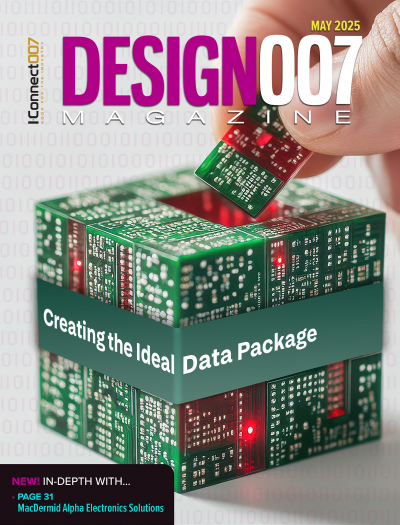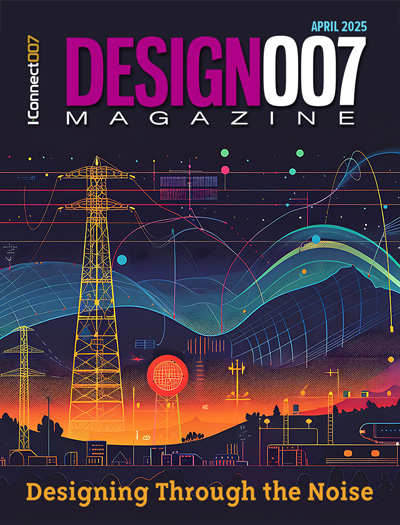-

- News
- Books
Featured Books
- design007 Magazine
Latest Issues
Current Issue
All About That Route
Most designers favor manual routing, but today's interactive autorouters may be changing designers' minds by allowing users more direct control. In this issue, our expert contributors discuss a variety of manual and autorouting strategies.

Creating the Ideal Data Package
Why is it so difficult to create the ideal data package? Many of these simple errors can be alleviated by paying attention to detail—and knowing what issues to look out for. So, this month, our experts weigh in on the best practices for creating the ideal design data package for your design.

Designing Through the Noise
Our experts discuss the constantly evolving world of RF design, including the many tradeoffs, material considerations, and design tips and techniques that designers and design engineers need to know to succeed in this high-frequency realm.
- Articles
- Columns
- Links
- Media kit
||| MENU - design007 Magazine
Just Ask Happy: Calculating Trace Temps in a Vacuum
July 7, 2020 | I-Connect007 Editorial TeamEstimated reading time: 1 minute
We asked for you to send in your questions for Happy Holden, and you took us up on it! The questions you've posed run the gamut, covering technology, the worldwide fab market, and everything in between. Enjoy.
Q: For space applications (without air), how should we calculate external layer current-carrying traces against the IPC-2221 (formerly IPC-D-275) charts?
A: I have never studied that, so I turned this question over to an expert, my friend Mike Jouppi, former committee chair of IPC-2152 Standard for Determining Current Carrying Capacity in Printed Board Design. This standard will provide many answers to your questions. Mike wrote Chapters 22 and 23 in the seventh edition of the Printed Circuits Handbook, edited by Clyde F. Coombs and me.
Mike answered: I'm a mechanical engineer who worked as a career thermal analyst. The charts in IPC-2152 in almost all cases will be conservative (both air and vacuum environments). The vacuum is for space environments. The purpose behind these charts is misconstrued by most users. My intention when they were developed was to use these charts as a baseline for developing thermal models that could be used to better understand the actual temperature rise of conductors in actual designs, which I did for my own design purposes. The concept did not catch on.
There is a significant difference between the temperature rise in a conductor, tested per IPC-TM-2.5.4.1a, and most PWB design configurations. The reason is that most designs have copper ground and power planes that conduct energy away from the traces. In addition, most designs in space applications have a significant conduction path from the PWB through-bolted fasteners or wedge locks to a sink.
Since the question does not include IPC-2152, I would recommend researching IPC-2152 and accounting for the power dissipations in the traces in the thermal design. I also recommend accounting for the conductor power dissipation in all designs, especially if the designers are not familiar with sizing parallel conductors. Parallel conductors are easily managed with accounting for conductor losses (power dissipation). FYI: It was the power dissipation in conductors that motivated me to lead the development of IPC-2152.
To pose your own question for Happy Holden, take the survey by clicking here.
Suggested Items
The Evolution of Picosecond Laser Drilling
06/19/2025 | Marcy LaRont, PCB007 MagazineIs it hard to imagine a single laser pulse reduced not only from nanoseconds to picoseconds in its pulse duration, but even to femtoseconds? Well, buckle up because it seems we are there. In this interview, Dr. Stefan Rung, technical director of laser machines at Schmoll Maschinen GmbH, traces the technology trajectory of the laser drill from the CO2 laser to cutting-edge picosecond and hybrid laser drilling systems, highlighting the benefits and limitations of each method, and demonstrating how laser innovations are shaping the future of PCB fabrication.
Day 2: More Cutting-edge Insights at the EIPC Summer Conference
06/18/2025 | Pete Starkey, I-Connect007The European Institute for the PCB Community (EIPC) summer conference took place this year in Edinburgh, Scotland, June 3-4. This is the third of three articles on the conference. The other two cover Day 1’s sessions and the opening keynote speech. Below is a recap of the second day’s sessions.
Day 1: Cutting Edge Insights at the EIPC Summer Conference
06/17/2025 | Pete Starkey, I-Connect007The European Institute for the PCB Community (EIPC) Summer Conference took place this year in Edinburgh, Scotland, June 3-4. This is the second of three articles on the conference. The other two cover the keynote speeches and Day 2 of the technical conference. Below is a recap of the first day’s sessions.
Preventing Surface Prep Defects and Ensuring Reliability
06/10/2025 | Marcy LaRont, PCB007 MagazineIn printed circuit board (PCB) fabrication, surface preparation is a critical process that ensures strong adhesion, reliable plating, and long-term product performance. Without proper surface treatment, manufacturers may encounter defects such as delamination, poor solder mask adhesion, and plating failures. This article examines key surface preparation techniques, common defects resulting from improper processes, and real-world case studies that illustrate best practices.
RF PCB Design Tips and Tricks
05/08/2025 | Cherie Litson, EPTAC MIT CID/CID+There are many great books, videos, and information online about designing PCBs for RF circuits. A few of my favorite RF sources are Hans Rosenberg, Stephen Chavez, and Rick Hartley, but there are many more. These PCB design engineers have a very good perspective on what it takes to take an RF design from schematic concept to PCB layout.


